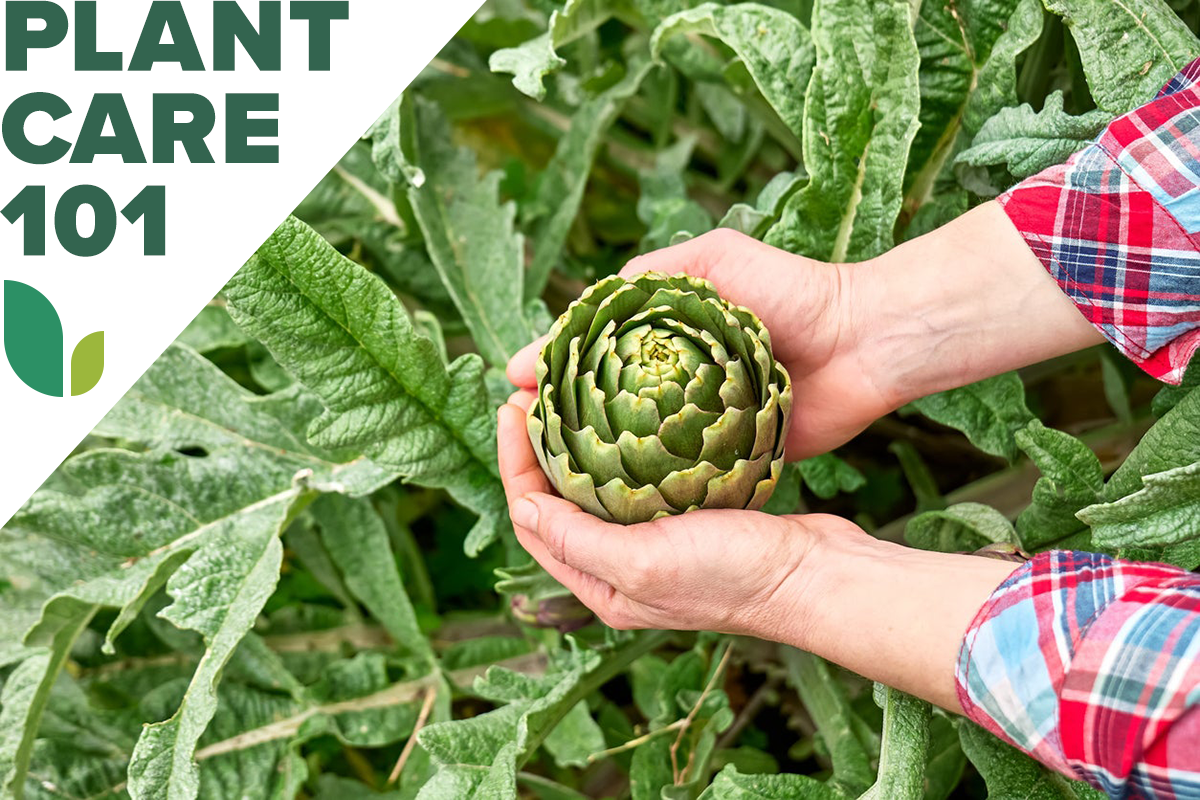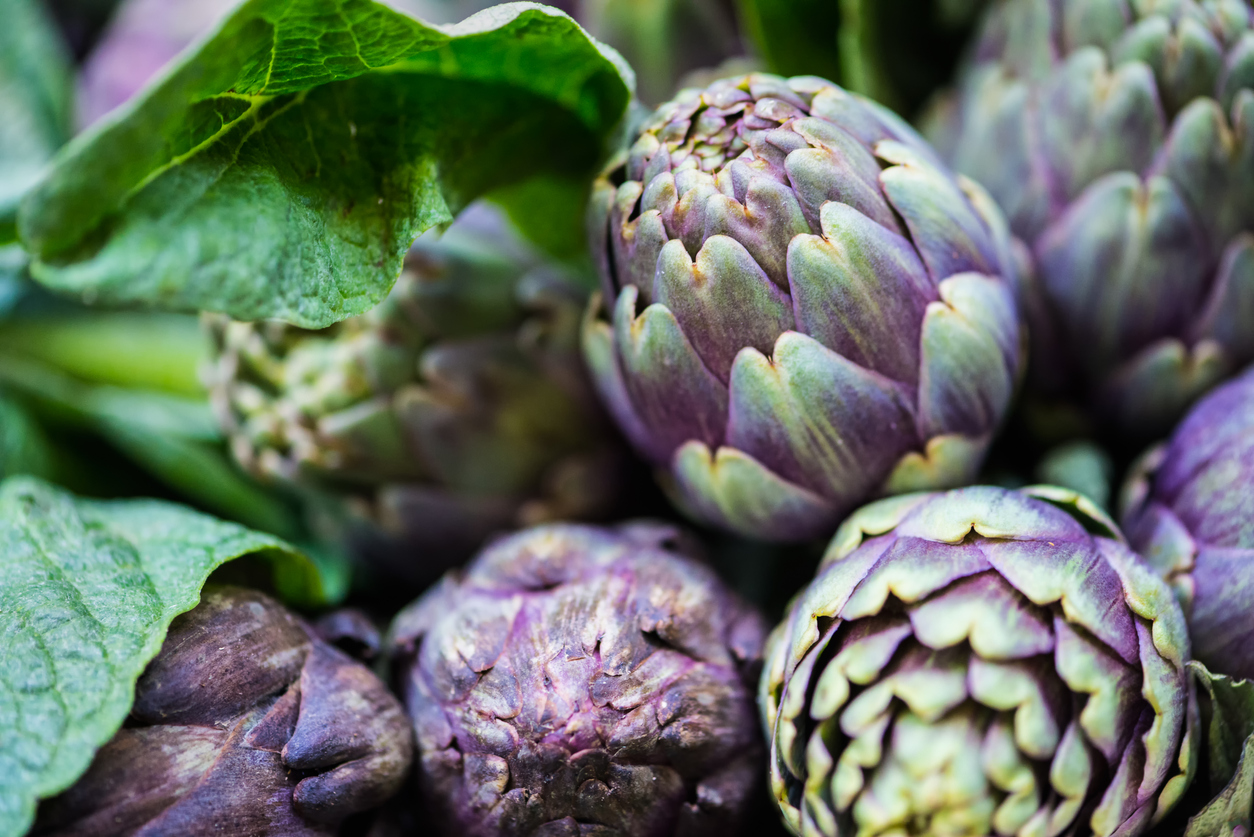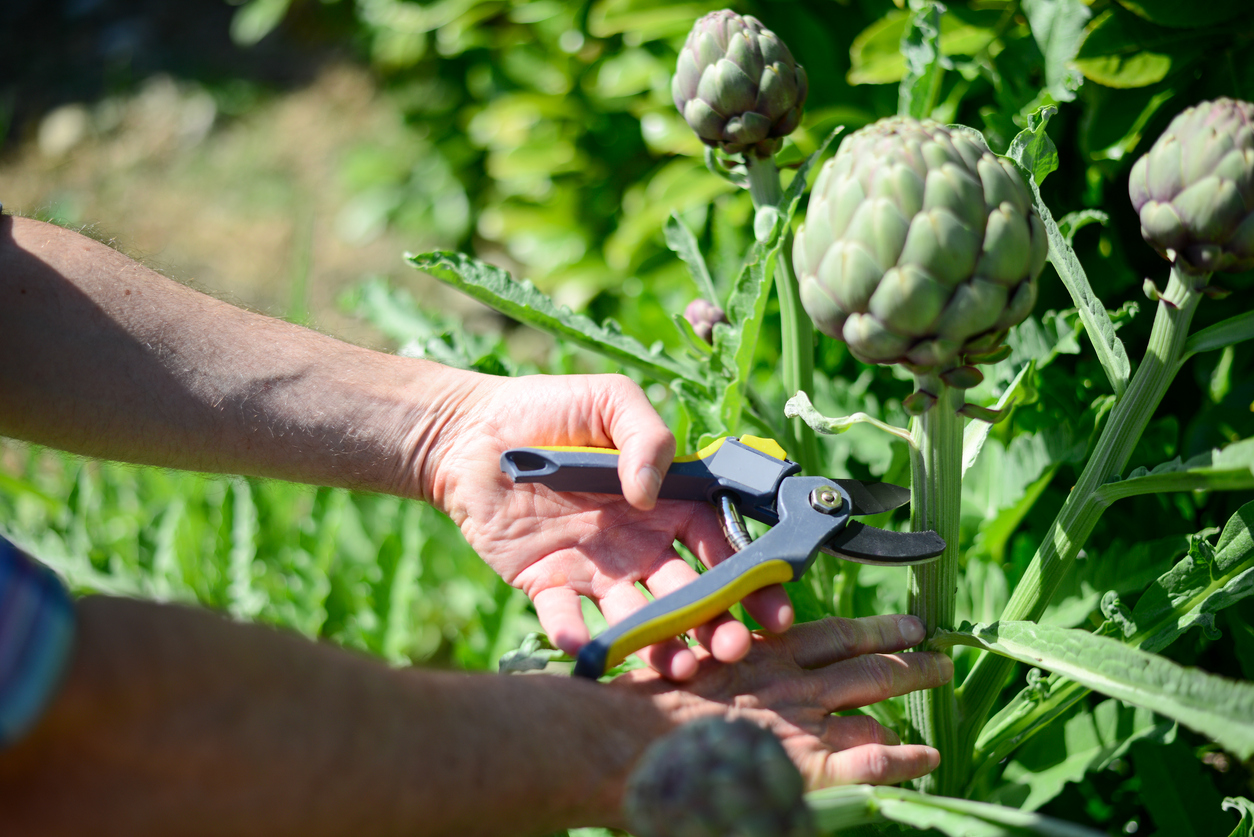

We may earn revenue from the products available on this page and participate in affiliate programs. Learn More ›
Growing artichokes at home can be tricky, but not because they’re difficult to grow. Instead, it’s because most require a 5-month season to mature, yet they prefer cool—but not freezing—conditions. Also, most artichoke cultivars are perennial vegetables, so the plants usually don’t bud until their second year.
If you are considering how to grow artichokes in a cold climate and in a single season, you will need to choose one of the rarer annual types or use vernalization (cold treatment) to delude your plants into believing they have experienced winter when they haven’t.
Growing Artichokes at a Glance
Common Name: Globe artichoke
Scientific Name: Cynara cardunculus (Scolymus group)
Hardiness Zone: 6 to 10
Soil: Moist, fertile, well-draining
Light: Full sun
Water: High
Food: Organic fish fertilizer
Propagation: Division or seeds
Safety: Can cause choking, contact dermatitis
Artichoke Characteristics

Mature artichoke plants reach 3 to 4 feet in height, with lobed silver-green foliage and 5-foot flower stalks. Their buds are ready to be harvested once the stalks have produced green pine cone-like buds 3 to 7 inches in diameter. The largest (primary) ones appear at the tips of the stalks, while those further down are called secondary or baby artichokes.
Edible parts include the artichoke heart and the bases of its bracts. If left unharvested, the buds will eventually open into purple thistle-like flowers.
In the warmth of USDA Hardiness Zone 10, artichoke plants generally crop between early fall and late spring. In zones 8 and 9, they produce most of their buds in early summer. However, they can survive winters as far north as zone 6 if they are cut back and covered with upended baskets and piles of leaves. In those colder climates, buds typically won’t appear until midsummer to autumn.
Recommended Artichoke Varieties
Choosing the best artichoke variety depends mostly on the growing zone and typical climate conditions. Nearly all commercial production of artichokes takes place in temperate climates of California.
- Emerald: This “jewel” produces 5-inch artichokes on 5-foot plants in 150 days and doesn’t require chilling, making it ideal for hot climates.
- Green Globe: This open-pollinated heirloom reaches 6 feet high with 3- to 4-inch globes in 150 to 210 days; it is cold-hardy to zone 6.
- Imperial Star: This 3-foot annual produces 3- to 4-inch fruits in 85 days in hotter zones (zone 9 and warmer) and requires vernalization.
- Violetto di Romagno: This type tops out at 5 feet, producing lots of 3-inch violet fruits within 85 to 100 days. It is cold-hardy to zone 6.
Planting Artichokes
In general, start seeds indoors about 8 weeks before the last frost date, thinning them to one plant per container. When starting artichokes from seed in the North, sow them in late January indoors. Move the seedlings outdoors for at least 10 to 20 days in March or April when temperatures remain below 50 degrees Fahrenheit but above freezing.
When is the best time to plant artichokes?
Set out artichoke root divisions in autumn or winter in USDA zones 8 to 10. Further north, wait until 2 weeks before your last frost to plant seedlings, but be sure to give them the type of vernalization described above first. A cold frame can keep them cool but safe from freezing.
Where can artichokes grow?
Choose a location in full sun with fertile, well-draining soil with a pH of 6.5 to 8. In extremely hot climates, locate your artichoke bed where it receives morning sun and afternoon shade. Also, be careful to place these tall plants where they won’t shade lower-growing vegetables.
How do you plant artichokes?
Artichokes typically produce well for about 3 years where they grow as perennials, and their lifespan can reach 15 years in the right growing conditions. Every few years, they should be divided or replaced with new plants. When grown as an annual, plant artichoke seedlings from indoors or transplants from a nursery in the same manner.
- Dig a hole large enough to plant a root division vertically with its crown about 2 to 4 inches below soil level. Position a potted plant or seedling at the same level it grew in its container.
- Backfill the soil around the roots or root ball.
- When setting out more than one plant, place them 3 to 6 feet apart.
Can you grow artichokes in containers?
To grow an artichoke plant in a container, choose a pot that is at least 24 inches in diameter and fill it with organic potting mix. If you live in a zone where artichokes aren’t hardy, you will need to move the pot and its occupant to a protected location—such as an unheated garage—where temperatures remain cool but above freezing over winter to keep it as a perennial vegetable.
Watering Artichokes

When actively growing, your artichoke plants should receive 1 to 2 inches of water per week, either via irrigation or rainfall or every few days. Apply about 4 inches of compost or other organic mulch to help keep their soil damp and suppress weeds.
In hot, dry climates—such as in Arizona—artichokes often begin to die back during the summer months. If that happens, you should cease watering them and allow them to drop into dormancy. They should resprout once cooler temperatures return in autumn.
Fertilizing Artichokes
Before planting artichokes, cover their bed with 2 inches of compost and dig it into the top 6 to 8 inches of soil to add organic matter. About a month after setting out the plants, begin feeding them at least once per month while they are actively growing with a liquid fish fertilizer such as 2-4-1. Don’t feed the artichokes during the months of the year when they are dying back or dormant.
Pruning Artichokes
Once you have picked all of the artichokes on a stalk, prune the stalk back to about an inch above the ground to encourage the plant to produce new growth—and more buds. In zones 6 and 7, cut the plants back to 1 foot tall in late autumn and tie the 1-foot stalks together with twine (to help protect the root crown beneath them) before covering them with inverted baskets and piles of leaves.
Propagating Artichokes
Because artichokes don’t come entirely true from seed, it usually is best to purchase nursery divisions or to divide the plants you already have. Do the latter at whatever season you would normally set out artichokes in your climate. Simply select a plant that has more than one crown and use a spade to slice one or more offsets off of the parent plant; replant offsets elsewhere.
If starting seeds, sow artichoke seeds ¼ inch deep in damp and sterile seed starting mix and keep them between 70 and 80 degrees Fahrenheit. They should germinate within 8 to 12 days.
Safety Considerations
When consuming an artichoke, eat only the heart and the tender bases of the bracts. Avoid the choke, the hairy purple part of the vegetable. Though not actually poisonous, it poses a choking risk
Also, keep in mind that artichokes may cause contact dermatitis (rashes) on the skin of people who handle them, especially those—such as farm and grocery store workers—who handle them frequently. It’s a good idea for people with sensitive skin to wear gloves when in contact with the vegetables until after they are cooked.
Potential Pests and Diseases
Aphids often gather on artichoke buds but can easily be removed with a strong stream of water from a spray bottle or hose, applied in early morning so the plants will dry off quickly. If slugs attack the plants, as evidenced by large holes in their foliage, apply slug bait such as iron phosphate granules to the soil around them. Use about 1 teaspoon of the granules per square yard of ground and reapply it after heavy rains.
Harvesting Artichokes

A typical plant will produce 6 to 20 artichokes per plant, a few of which will be larger primary buds like those seen in grocery stores.
When is the best time to harvest artichokes?
Harvest artichoke buds when they are at least 3 inches in diameter, before their bracts start to open. The proper season for that will vary with your climate, usually autumn through spring for zone 10, spring to early summer for zones 8 and 9, and mid-summer to autumn for cooler zones.
How do you harvest artichokes?
Unlike most vegetables, artichokes should be harvested before they bloom by following these steps:
- Use pruning shears or gardening shears to snip off artichokes, leaving 1½ to 3 inches of stem attached to each one.
- Cut the largest top artichoke from each stalk first, and leave the lower ones to mature for a bit longer before harvesting them.
- Wash the vegetables and enclose them inside a plastic bag for refrigeration.
How do you store artichokes?
Artichokes will keep for about 2 weeks in the refrigerator. Texas AgriLife Extension recommends “near 32 degrees Fahrenheit with over 90 percent relative humidity” for optimal storage conditions. If you produce too many artichokes to eat them all fresh, you can freeze, can, or dry them either whole or just the hearts.
Looking for more decorative vegetables and herbs? Check out our guides on growing kale, lavender, and saffron.
